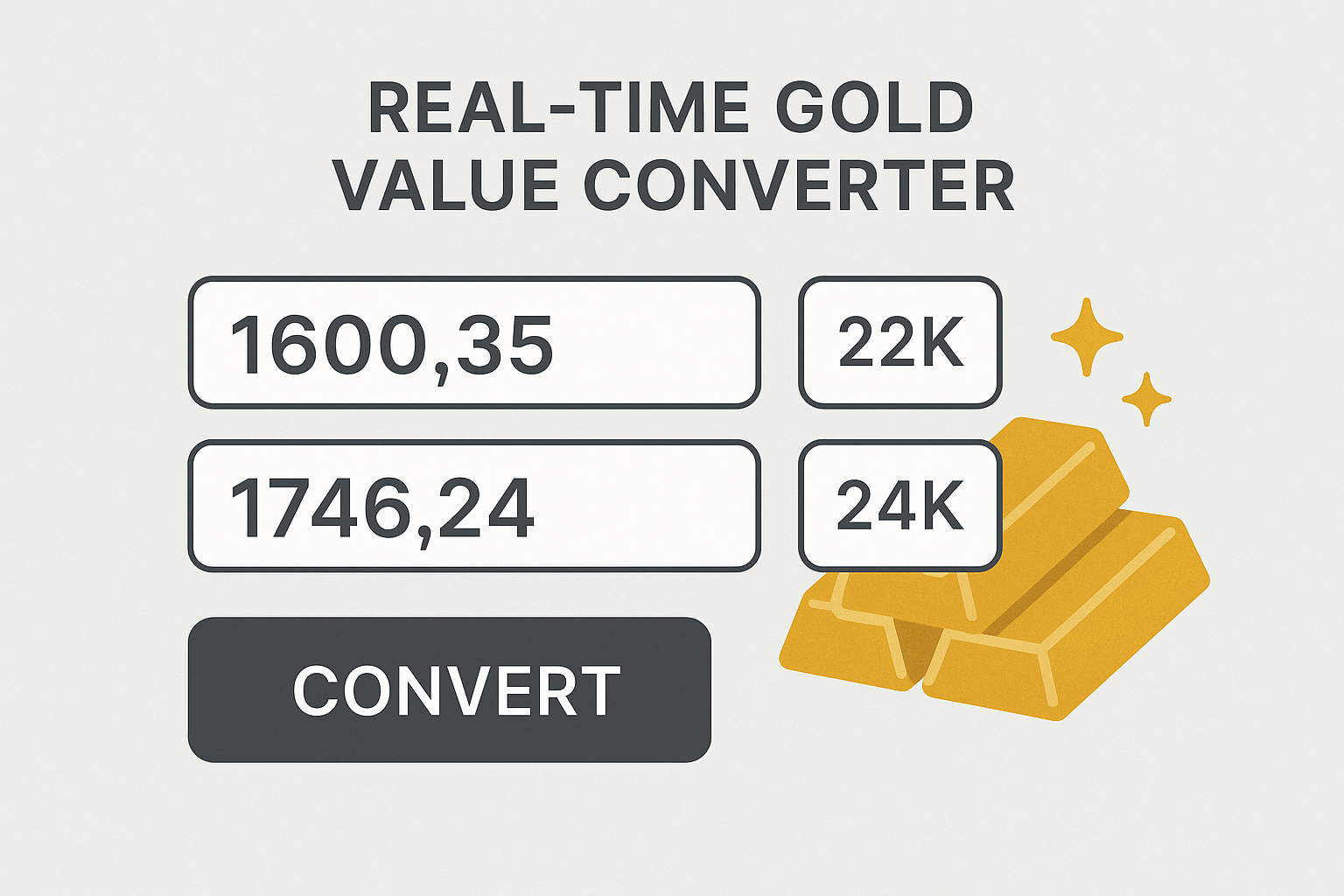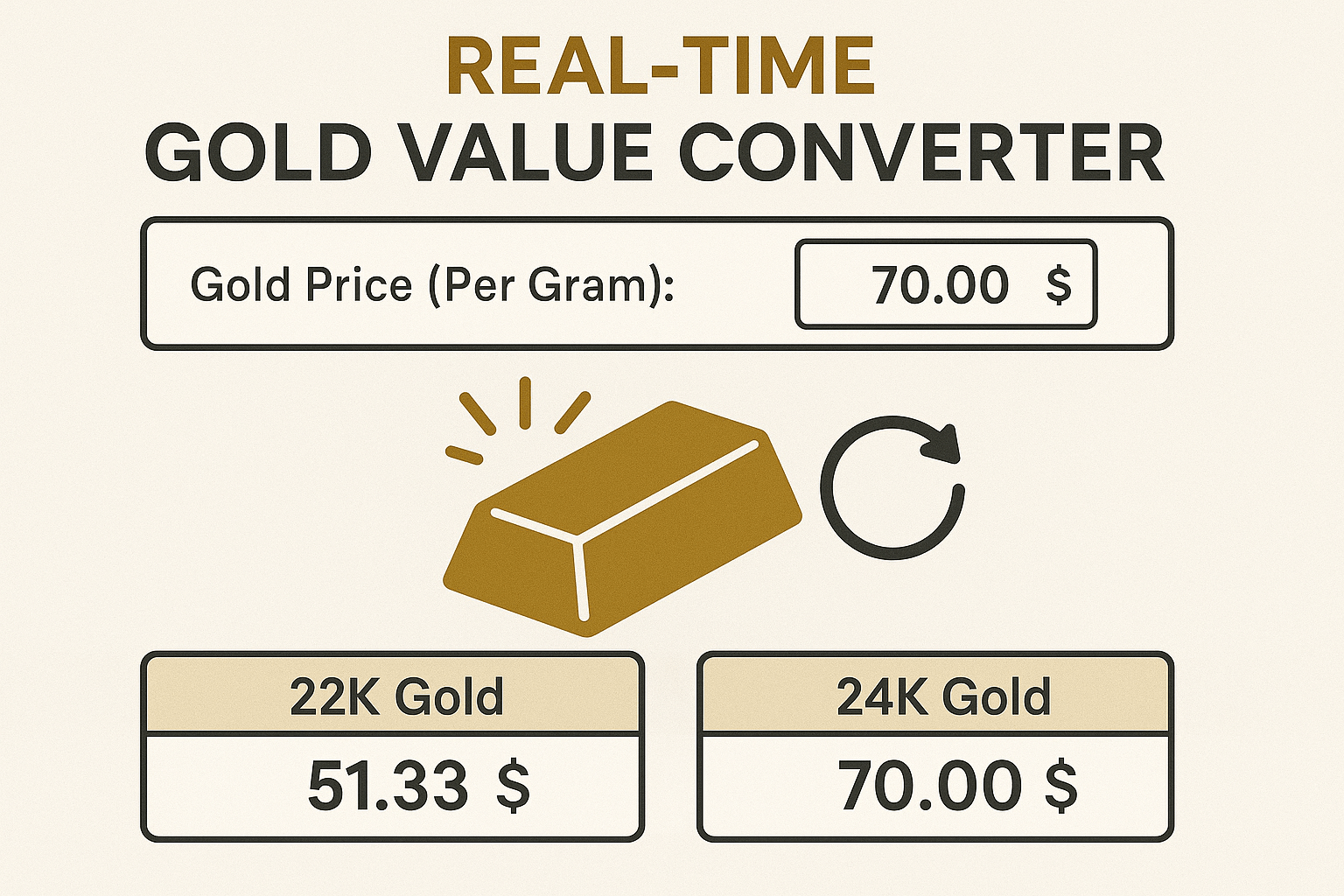From ancient empires to modern investment portfolios, gold has stood the (Real-Time Gold Value Converter) test of time as a symbol of wealth and a haven for investors. But in today’s fast-moving market, its price fluctuates constantly. How can you possibly keep up? This is where a powerful tool comes into play: a Real-Time Gold Value Converter. Whether you’re selling an old family heirloom, buying a new piece of jewelry, or making a strategic investment, understanding the live value of different purities like 22K and 24K is crucial. This comprehensive guide will demystify the process, turning you from a novice into a knowledgeable gold enthusiast.
What Exactly is a Real-Time Gold Value Converter?
Imagine a digital scales that updates itself every second with the global market price of gold. A Real-Time Gold Value Converter is precisely that. It’s an online tool, often a website or app, that takes the live, spot price of gold and allows you to calculate the value of your specific gold item based on its weight and purity (karat).
It bridges the gap between the abstract, per-ounce price quoted on financial news and the tangible value of the gold ring in your drawer. These converters are powered by complex algorithms that pull data from major global exchanges like the LBMA (London Bullion Market Association), COMEX (Commodity Exchange Inc.), and others, ensuring you get the most accurate, up-to-the-minute valuation.
The Foundation: Understanding Karats (22K vs. 24K)
Before you can use a converter, you must understand what you’re converting. The karat (K) system measures the purity of gold, with 24K being the purest form.
-
24K Gold: This is 100% (or 99.9%) pure gold. It’s a bright, rich yellow color and is very soft and malleable. You’ll rarely find jewelry made from 24K gold because it’s too soft for everyday wear; it would easily scratch, dent, and lose its shape. It is primarily used for investment bars (bullion) and coins.
-
22K Gold: This gold is 91.6% pure (22 parts gold, 2 parts other metals). The added metals (like copper or silver) make it much more durable for jewelry while retaining a high gold content and a vibrant color. It’s a very popular choice for high-purity jewelry, especially in South Asian and Middle Eastern markets.
Other common purities include 18K (75% gold) and 14K (58.3% gold), which are standard for most Western jewelry.
How to Use a Real-Time Gold Value Converter: A Step-by-Step Walkthrough
Let’s break down how you would actually calculate the value of a 22K gold chain.
-
Find the Weight: Precisely weigh your item in grams using a digital scale. For our example, let’s say the chain weighs 20 grams.
-
Identify the Purity: The chain is stamped 22K.
-
Open a Converter Tool: Go to a reputable converter website like Kitco or APMEX.
-
Input the Data:
-
The tool will show the live spot price. Assume it’s $65 per gram (for pure, 24K gold).
-
Select the currency (e.g., USD).
-
Enter the weight: 20 grams.
-
Select the purity: 22K.
-
-
Understand the Calculation: The converter won’t just multiply 20 grams by $65. Since your item is 22K (91.6% pure), it first calculates the pure gold content.
-
Pure Gold Content = Total Weight × (Purity Percentage / 100)
-
Pure Gold Content = 20 grams × (91.6 / 100) = 18.32 grams of pure gold.
-
-
See the Result: The tool then multiplies this pure gold content by the live spot price.
-
Value = 18.32 grams × $65/gram = $1,190.80
-
This $1,190.80 is the melt value or intrinsic bullion value of your gold. It is the baseline value before any premiums for craftsmanship, brand name, or retailer markup are added.
https://images.unsplash.com/photo-1604594849809-dfedbc827105?auto=format&fit=crop&q=80&w=1000&h=600Alt Text: Using a smartphone app for a real-time gold value converter to assess gold jewelry.
Why Are 22K and 24K Rates Different?
The difference in rates is purely a function of purity. Since 24K gold is 100% pure, its price per gram is the benchmark “spot price.” 22K gold contains only 91.6% gold, so its value is inherently 8.4% less per gram than the spot price.
-
24K Rate: Directly tied to the live spot price.
-
22K Rate: Calculated as (Spot Price) × (22/24) or (Spot Price) × 0.916.
Therefore, if the spot price is $65 per gram for 24K gold, the base value for 22K gold would be approximately $59.54 per gram ($65 × 0.916).

Factors That Influence the Real-Time Price of Gold
The “why” behind the constantly changing numbers is fascinating. A Real-Time Gold Value Converter reflects a symphony of global economic forces:
-
Global Supply and Demand: Basic economics. Increased demand from jewelry or industry with constrained supply drives prices up.
-
The US Dollar: Gold is priced in U.S. dollars. A weaker dollar makes gold cheaper for holders of other currencies, boosting demand and price. A stronger dollar often has the opposite effect.
-
Inflation and Interest Rates: Gold is a classic hedge against inflation. When interest rates are low, gold becomes more attractive because it doesn’t pay interest or dividends.
-
Geopolitical Uncertainty: Wars, political instability, and global crises drive investors toward “safe-haven” assets like gold, pushing its price higher.
-
Central Bank Activity: When central banks around the world buy gold to diversify their reserves, it creates significant demand.

Beyond the Converter: What Your Gold is Really Worth
It’s vital to manage expectations. The figure from a Real-Time Gold Value Converter is not what a jeweler will pay you for your necklace, nor is it the retail price you’ll pay in a store.
-
If You’re Selling (to a refiner or pawn shop): You will be offered a price below the melt value. The buyer needs to make a profit and account for the cost of refining and their operational risks. You might receive 70-90% of the calculated melt value.
-
If You’re Buying (jewelry): You will pay a price significantly above the melt value. This premium covers the craftsmanship, design, brand markup, retailer’s profit, and taxes. A piece of jewelry is not just a lump of metal; it’s a finished product.
The converter gives you the powerful knowledge of the raw material’s value, preventing you from being drastically lowballed when selling or overcharged when buying.
Frequently Asked Questions (FAQs)
Q1: How often does the ‘real-time’ price update?
A: Truly real-time converters update every few seconds to a minute, reflecting the live bid and ask prices on major commodities exchanges.
Q2: Is the price the same worldwide?
A: The core spot price in USD is global, but the final value in your local currency will depend on the foreign exchange rate. Local markets may also have small premiums or discounts based on supply and demand.
Q3: Can I use these converters for gold-plated or gold-filled items?
A: No. These tools are only for solid gold items. Gold-plated items have a microscopic layer of gold over a base metal and have almost no melt value.
Q4: Where is the best place to find a reliable real-time gold converter?
A: Reputable bullion dealers (like APMEX, JM Bullion), financial news sites (like Bloomberg, Kitco), and some currency converter websites offer reliable tools.
Q5: Why does the price on the converter not match the price I see in a jewelry store window?
A: As explained above, the jewelry store price includes a substantial premium for making the jewelry, the store’s rent, staff, marketing, and profit. The converter only shows the value of the raw gold content.
Conclusion: Empower Yourself with Knowledge
A Real-Time Gold Value Converter is an indispensable tool for anyone interacting with gold. It demystifies a complex market and provides a transparent baseline for value. By understanding the crucial difference between 22K and 24K rates and the factors that move them, you are no longer in the dark. You can negotiate with confidence, invest with clarity, and appreciate the true worth of your assets. Remember, the number on the screen is the starting point for a conversation, not the final word. Use this knowledge wisely, and let it guide you to make informed and smart financial decisions in the glittering world of gold.
Disclaimer: This article is for educational and informational purposes only and does not constitute financial, investment, or professional advice. The gold market is volatile, and prices can change rapidly. The value calculated by any converter is an estimate and may not reflect the actual price you receive or pay in a transaction. You should always conduct your own research and consult with a qualified professional before making any financial decisions. If you have any concerns regarding the content of this post, please refer to our DMCA policy and guide for content removal procedures.
